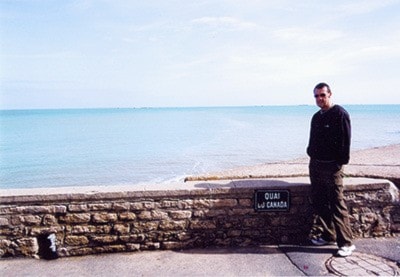South Green Lake resident Jim Butterfield has a keen interest in war history, especially the five years his father, Ammon, spent serving in the Second World War.
Inspired by the stories Ammon shared in his later years, just before passing on, Jim decided to follow in his father’s wartime footprints across France in the fall of 2010.
Ammon signed up for the Royal Canadian Army Service Corps (RCASC) in June 1940 at age 29.
As one of the veteran’s four sons growing up in Nanaimo, Jim says he never knew much about his father’s war experiences.
“My dad didn’t really talk much about the war until [later in life], when he was 90-plus. He was 95 when he died.
“It seemed to be, [with] the Canadian soldiers – when they came home, they put that behind them, and didn’t want to relive it or talk about it.”
After his father’s death, Jim, as the oldest living son, received a box of Ammon’s war mementoes and he found old photos, bullets and pay stubs.
“I had decided to take some of his ashes and spread them at Juno Beach. Then, when I got some of that information, I wanted to track some of the places where he had been.”
A lot of the photos were of two foreign families, which were a bit of a mystery to Jim as to whether they were simply wartime friends, or people Ammon had actually billeted with in their homes.
“He’d been in touch with them just after the war, and I made a real effort to try to contact these families ... because I’ve got their [original] addresses.”
He sought out both locations but, unfortunately, didn’t find the families.
At the first house was a woman who spoke only French, but Jim comprehended enough to gather she knew nothing about anyone living there in the 1940s.
Finding the second address was more difficult, but it led him to an interesting experience.
“I was trying to find it, and there were these two older French guys working on a vehicle, and I showed them a picture of my dad at this address. One fellow, right on the spot, he put down his tools and led me right to the house.
“It kind of showed the [foreign] respect for the Canadian soldiers because this guy was really helpful.”
Ammon was initially a driver in England during the Second World War, and then he also worked as a cook, an aide, and in active duty in France.
Jim and his travelling party set out from Dover, England and headed to Calais, France where they stayed a week in the Normandy area.
He spent much of this time at, or near, Juno Beach – the site where Canadian soldiers landed for the famous D-Day battle – including a stretch known as Mike’s Beach, where his father had landed.
From there, Pte. Butterfield had served with the 578 Company of 500-600 men, delivering petrol and rations from the beach to the front lines. In his role as an aide to the commanding officer, Ammon had travelled almost daily between Cruelly and Villiers-le-Sec, camping down in the trenches and under army trucks to avoid the shells.
“I spread some of my dad’s ashes [there] and actually brought some of the sand back from Juno Beach, too – a little vial for our family.
“After looking at Juno Beach and going through the museum there, where all the casualties were taken, I went up to the cemetery.
There’s row-on-row [of war graves]; and the thing that hits you is their ages – they’re kids. I’d say a third of them were 20 years of age or under.”
It is impossible to walk through there without tearing up a bit, Jim says, adding one epitaph reads: “My only son gave up his life for us. Will you be worthy?”
Jim adds he sometimes wonders if he would have the courage these young people had back then.
When veterans are asked if they were fighting for their country or for their Queen, he notes they often reply they were fighting for their comrades battling beside them.
Jim also visited a number of memorials and cemeteries around Vimy, including Vimy Ridge, where Canadian soldiers landed for the landmark battle during the First World War.
Their success became a national symbol of achievement and sacrifice, so 25 years afterward, Pte. Butterfield also visited the site where he did his tour of duty.
“I have a picture of my dad standing with a couple of other soldiers at Vimy Ridge, and I got a picture taken of myself standing in the same spot, something like 60 years later.”
The museum at Vimy gave him a poignant understanding of what these soldiers did, Jim explains.
“The most dangerous job was the messenger’s because they were all in the trenches ... the average life expectancy was seven days, and they were all volunteers.”
Travelling together with his wife, Rosalyn, and a couple of friends from Prince George, he also visited Italy where the other fellow’s father had fought.
Having visited Europe about 10 times, Jim says he always searches out battle sites, war memorials and historical artifacts.
“I’ve been all over Europe and the memories I have are really war-based. It’s not the things you see; it is the feelings you have.”
Jim notes he does a lot of reading to learn as much as he can, especially about the Second World War.
“When you see the bigger picture, you realize that after all this, there are no winners in war.”
The first part of the story, with Pte. Butterfield’s own experiences in France, was published in the last year’s Remembrance Day 2012 section of the 100 Mile House Free Press.
